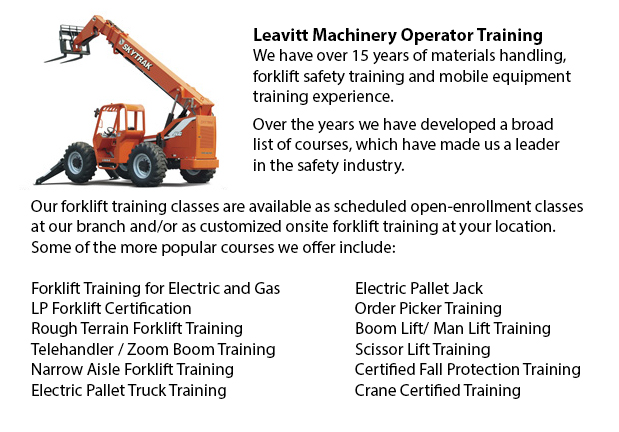
Sudbury Zoom Boom Training - Zoom Boom Training is designed to train operators on variable reach forklifts. The objectives of the training are to impart an understanding of the physics of the machinery, and to outline the operator's job. This course abides by North American safety standards for lift trucks. Zoom boom training and certification is available at our site or at the company's location, provided there are a minimum number of trainees. Certification given upon successfully finishing it is valid for three years.
A telescopic handler (otherwise called a telehandler) is similar in some ways to both a crane and a forklift. It is a helpful equipment designed together with a telescopic boom that could lift upwards and extend forward. A variety of attachments could be fitted on the end of the boom, like bucket, pallet forks, muck grab or lift table. It is popular in industry and agriculture settings.
Telehandlers are most commonly utilized along with the fork attachment in order to shuttle loads. The units have the advantage that they could get to places not accessible to standard forklifts. Telehandlers are capable of removing loads which are palletized from within a trailer and placing them on high places such as rooftops. For certain applications, they could be much more efficient and practical than a crane.
While lifting heavy loads, the telehandler could experience some unsteadiness. When the boom is extended very far with a load, the machinery will become more unsteady. Counterweights in the rear help, but don't solve the problem. The lifting capacity rapidly decreases when the working radius increases. Several equipment come with front outriggers which extend the lifting capacity when the machinery is stationary.
A load chart helps the operator to determine whether a given load is too heavy. Factors like for instance load weight, boom angle and height are calculated. Various telehandlers have sensors which cut off further control or provide a warning if the unit is in danger of destabilizing.
-
Wheel and Track Loader Training in Sudbury
Lift trucks are obtainable in several different models that have different load capacities. The majority of average forklifts used in warehouse environment have load capacities of 1-5 tons. Bigger scale units are utilized for heavier loads, like for... More -
Sudbury Aerial Lift Certification
Sudbury Aerial Lift Certification - Aerial Lift Certification is for individuals who requires an in-depth understanding of aerial lift safety. Inspectors and operators, supervisors, maintenance workers and construction craftsmen must perform a traini... More -
Sudbury Forklift Certification Schools
Sudbury Forklift Certification Schools - Within North America, forklift certification is mandatory, making forklift training programs necessary for both the company and their employees working as forklift operators. Forklift training focuses on healt... More -
Sudbury Boom Lift Operator Training
Sudbury Boom Lift Operator Training - A cherry picker refers to a type of aerial work platform. Cherry pickers include a platform or bucket at the end of a hydraulic lifting system. The device is likewise called a man lift, boom lift, basket crane or... More -
Sudbury Telehandler Certification
Sudbury Telehandler Certification - Telehandler certification programs are both for operators who have some experience driving a standard forklift and for those with no experience. The real-world training offered by these courses produces graduates w... More -
Operator Safety Training, Re-Qualification Training, In-House Instructor Training in Sudbury
Lift trucks are utilized in just about all industrial construction sites and in warehouse operations and in boat yards. The reach feature of a lift truck is a vital component used in several applications like for example when a shelving system is bei... More -
Crane / Overhead Crane / Self-Erect Crane / Truck Mounted Crane / Hydraulic Cranes Training in Sudbury
Bridge cranes or overhead cranes are a type of industrial material handling crane making use of a line and hook apparatus which runs on a horizontal beam running along two widely separated rails. Lots of overhead cranes could be seen in a long factor... More -
Sudbury Forklift Safety Training
Sudbury Forklift Safety Training - Anyone who wants to operate a lift truck should take a forklift safety training course in order to become a certified forklift truck operator. There are a variety of ways to obtain forklift training. Programs are pr... More

Forklift Certification Sudbury
TOLL FREE: 1-888-254-6157
Sudbury, Ontario
forkliftcertificationsudbury.com
Email Us
About Us


